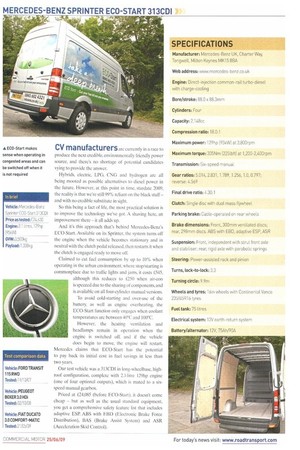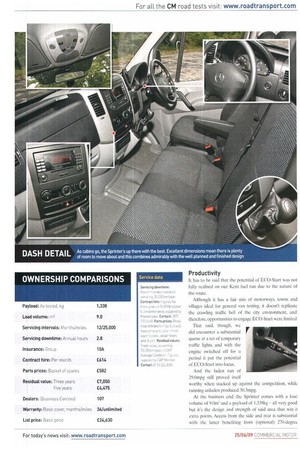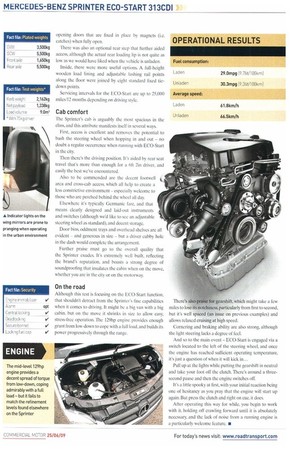CV manufacturers are currently in a race to produce the
Page 32

Page 33

Page 34

If you've noticed an error in this article please click here to report it so we can fix it.
next credible, environmentally friendly power source, and there's no shortage of potential candidates vying to provide the answer.
Hybrids, electric, LPG. CNG and hydrogen arc all being mooted as possible alternatives to diesel power in the future. However, at this point in time, stardate 2009, the reality is that we're still 99% reliant on the black stuff— and with no credible substitute in sight.
So this being a fact of life, the most practical solution is to improve the technology we've got. A shaving here, an improvement there — it all adds up.
And it's this approach that's behind Mercedes-Benz's ECO-Start. Available on its Sprinter, the system turns off the engine when the vehicle becomes stationary and in neutral with the clutch pedal released, then restarts it when the clutch is engaged ready to move oft Claimed to cut fuel consumption by up to 10% when operating in the urban environment, where stop/starting is commonplace due to traffic lights and jams, it costs £545. although this reduces to £250 when air-con is specced due to the sharing of components, and is available on all four-cylinder manual versions.
To avoid cold-starting and over-use of the battery, as well as engine overheating, the ECO-Start function only engages when coolant temperatures arc between 40"C and 100°C.
However, the heating ventilation and headlamps remain in operation when the engine is switched oft and if the vehicle does begin to move, the engine will restart. Mercedes claims that ECO-Start has the potential to pay back its initial cost in fuel savings in less than two years.
Our test vehicle was a 313CDI in long-wheelbase, highroof configuration, complete with 2.1-litre 129hp engine (one of four optional outputs), which is mated to a sixspeed manual gearbox.
Priced at £24,085 (before ECO-Start). it doesn't come cheap — but as well as the usual standard equipment. you get a comprehensive safety feature list that includes adaptive ESP. ABS with EBD (Electronic Brake Force Distribution), BAS (Brake Assist System) and ASR (Acceleration Skid Control).
Productivity It has to be said that the potential of ECO-Start was not fully realised on our Kent fuel run due to the nature of the route.
Although it has a fair mix of motorways, towns and villages ideal for general van testing, it doesn't replicate the crawling traffic hell of the city environment, and. therefore, opportunities to engage ECO-Start were limited, That said, though, we did encounter a substantial queue at a set of temporary traffic lights, and with the engine switched off for a period it put the potential of ECO-Start into focus.
And the laden run of 29.0mpg still proved itself worthy when stacked up against the competition, while running unladen produced 30.3mpg.
At the business end. the Sprinter comes with a load volume of 9.0m-1 and a payload of -1,33Rkg — all very good but it's the design and strength of said area that win it extra points. Access from the side and rear is substantial with the latter benefiting from (optional) 270-degrec
opening doors that are fixed in place by magnets (i.e. catches) when fully open.
There was also an optional rear step that further aided access, although the actual rear loading lip is not quite as low as we would have liked when the vehicle is unladen.
Inside, there were more useful options. A full-height wooden load lining and adjustable lashing rail points along the floor were joined by eight standard fixed tiedown points.
Servicing intervals for the ECO-Start are up to 25,000 miles/12 months depending on driving style.
Cab comfort
The Sprinter's cab is arguably the most spacious in the class, and this attribute manifests itself in several ways.
First, access is excellent and removes the potential to bash the steering wheel when hopping in and out — no doubt a regular occurrence when running with ECO-Start in the city.
Then there's the driving position. It's aided by rear seat travel that's more than enough for a 6ft 2in driver, and easily the best we've encountered.
Also to be commended are the decent footwell area and cross-cab access, which all help to create a less constrictive environment — especially welcome to those who are perched behind the wheel all day.
Elsewhere it's typically Germanic fare, and that means clearly designed and laid-out instruments and switches (although we'd like to see an adjustable steering wheel as standard), and decent storage.
Door bins, oddment trays and overhead shelves are all evident — and generous in size — but a driver cubby hole in the dash would complete the arrangement.
Further praise must go to the overall quality that the Sprinter exudes. It's extremely well built, reflecting the brand's reputation, and boasts a strong degree of soundproofing that insulates the cabin when on the move, whether you are in the city or on the motorway.
On the road
Although this test is focusing on the ECO-Start function, that shouldn't detract from the Sprinter's fine capabilities when it comes to driving. It might be a big van with a big cabin. but on the move it shrinks in size to allow easy, stress-free operation. The 129hp engine provides enough grunt from low-down to cope with a full load, and builds its power progressively through the range.
'There's also praise for gearshift, which might take a few miles to lose its notchiness, particularly from first to second, hut it's well spaced (an issue on previous examples) and allows relaxed cruising at high speed.
Cornering and braking ability are also strong, although the light steering lacks a degree of feel.
And so to the main event — ECO-Start is engaged via a switch located to the left of the steering wheel, and once the engine has reached sufficient operating temperature, it's just a question of when it will kick in...
Pull up at the lights while putting the gearshift in neutral and take your foot off the clutch. There's around a threesecond pause and then the engine switches off.
It's a little spooky at first, with your initial reaction being one of hesitancy as you pray that the engine will start up again. But press the clutch and right on cue, it does
After operating this way for while, you begin to work with it, holding off crawling forward until it is absolutely necessary, and the lack of noise from a running engine is a particularly welcome feature. •












































































































































